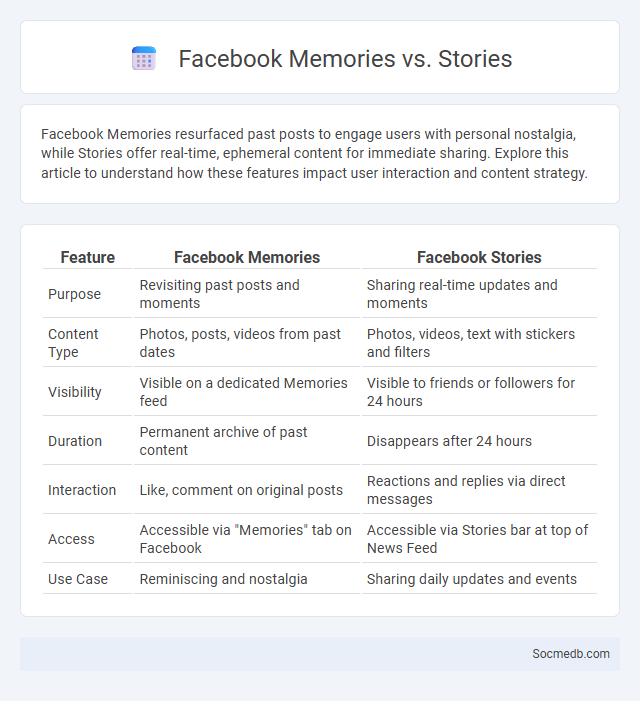
Photo illustration: Facebook Memories vs Stories
Facebook Memories resurfaced past posts to engage users with personal nostalgia, while Stories offer real-time, ephemeral content for immediate sharing. Explore this article to understand how these features impact user interaction and content strategy.
Table of Comparison
| Feature | Facebook Memories | Facebook Stories |
|---|---|---|
| Purpose | Revisiting past posts and moments | Sharing real-time updates and moments |
| Content Type | Photos, posts, videos from past dates | Photos, videos, text with stickers and filters |
| Visibility | Visible on a dedicated Memories feed | Visible to friends or followers for 24 hours |
| Duration | Permanent archive of past content | Disappears after 24 hours |
| Interaction | Like, comment on original posts | Reactions and replies via direct messages |
| Access | Accessible via "Memories" tab on Facebook | Accessible via Stories bar at top of News Feed |
| Use Case | Reminiscing and nostalgia | Sharing daily updates and events |
Introduction to Facebook Memories, Stories, and Memory
Facebook Memories helps you revisit past moments shared on the platform by highlighting photos, posts, and interactions from previous years. Stories enable you to share real-time updates and experiences with your friends through short-lived photos or videos that disappear after 24 hours. These features collectively enhance your social media experience by preserving and celebrating your personal history and ongoing connections.
What Are Facebook Memories?
Facebook Memories are personalized collections of past posts, photos, and activities that Facebook resurfaces to users on their timeline or notifications. These memories highlight significant moments such as birthdays, anniversaries, and shared experiences from previous years, encouraging reflection and social interaction. This feature leverages Facebook's data algorithms to curate relevant content based on user engagement and historical activity.
Understanding Facebook Stories
Facebook Stories allow you to share photos and videos that disappear after 24 hours, providing a dynamic way to engage with your audience. Utilizing features like stickers, music, and interactive polls enhances viewer interaction and increases content visibility. Understanding the platform's algorithm can help optimize your Stories' reach, making your social media efforts more effective.
Defining Memory: Digital vs. Human Recollection
Memory in social media differs fundamentally between digital archives and human recollection, with digital platforms storing vast amounts of data that can be retrieved instantly, while human memory selectively recalls information influenced by emotions and context. Your digital footprint is preserved through posts, likes, and interactions that create an external repository of experiences, contrasting with the subjective and often fallible nature of personal memory. Understanding this distinction highlights how technology extends your capacity to remember, yet also changes the way memories are accessed and valued.
Key Features: Memories vs. Stories
Social media platforms offer distinct features for sharing content, with Memories providing a way to revisit and relive past posts by resurfacing photos and updates from previous years, enriching user engagement through nostalgia. Stories, popularized by platforms like Instagram and Snapchat, deliver ephemeral content that disappears after 24 hours, encouraging real-time sharing and interaction. These features enhance user experience by combining long-term reflection with transient daily updates, catering to diverse user preferences.
User Engagement: Which Tool Works Best?
User engagement on social media platforms significantly depends on the chosen tool's ability to facilitate interaction, with features such as live polls, interactive stories, and comment responses driving higher participation rates. Tools like Hootsuite, Sprout Social, and Buffer offer robust analytics and scheduling functions that optimize content timing and engagement tracking, directly impacting user interaction metrics. Platforms integrating AI-driven insights and real-time engagement tracking demonstrate superior performance in boosting likes, shares, and comments, thereby enhancing overall user engagement effectiveness.
Privacy Concerns: Memories and Stories Compared
Social media platforms collect vast amounts of personal data, raising significant privacy concerns, especially when sharing memories and stories that often include sensitive information. Unlike ephemeral posts, saved memories and stories can be archived and accessed later, increasing the risk of unauthorized use or exposure. Users must navigate complex privacy settings and terms of service to protect their digital footprint from potential breaches or misuse.
Impact on Digital Memory and Personal Reflection
Social media significantly shapes digital memory by creating vast repositories of personal moments, interactions, and experiences accessible over time. Its platforms encourage continuous sharing and archiving, which influences how individuals curate and interpret their life narratives. This ongoing digital documentation fosters deeper personal reflection by enabling users to revisit past content and observe their growth, changes, and evolving identities.
Use Cases: When to Use Memories or Stories
Memories on social media serve to reconnect you with past moments, ideal for anniversaries or reflecting on personal milestones that deepen your audience's emotional engagement. Stories are best utilized for real-time, ephemeral content that captures daily activities, promotions, or behind-the-scenes glimpses, creating immediacy and fostering ongoing interaction. Your strategic use of Memories enhances long-term relationship building, while Stories drive immediate attention and frequent user engagement.
Future Trends in Facebook’s Memory Features
Facebook's memory features are evolving with advancements in artificial intelligence and augmented reality, enabling more personalized and immersive ways to relive past moments. You can expect enhanced memory curation tools that automatically highlight significant events and blend multimedia content for richer storytelling. Future updates will likely integrate predictive analytics to suggest memories based on context and emotional resonance, making your social interactions more meaningful and engaging.
 socmedb.com
socmedb.com